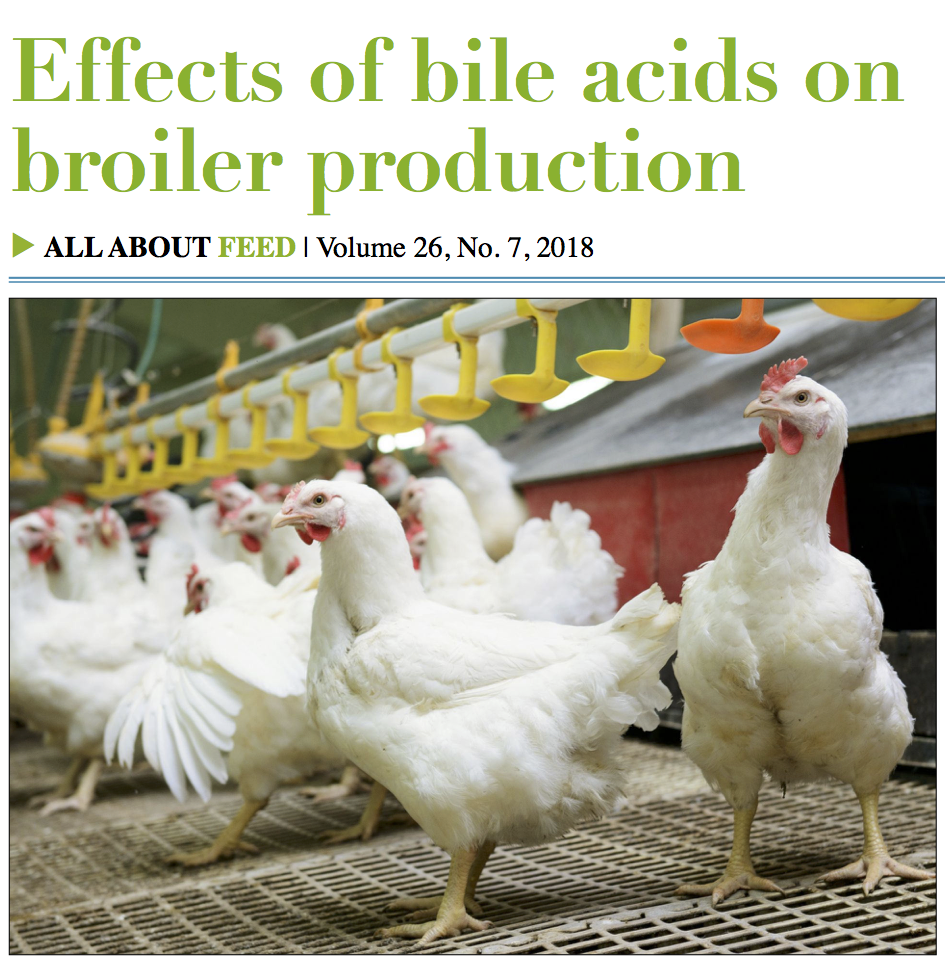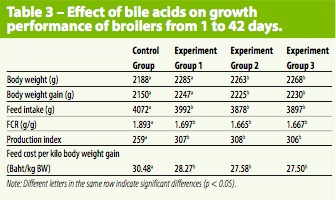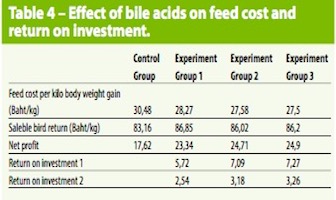▶ ALL ABOUT FEED: Effects of bile acids on broiler production

Due to the short growth cycle of broilers, optimising broiler nutrition is essential. When using high energy feed ingredients, bile acids can play a vital role in the process of fat digestion and absorption.
Due to the rapid growth and short housing time of broilers, conventional feeds are generally insuffi- cient to meet the birds nutritional needs, espe- cially those with higher energy requirements. As a high-energy feed ingredient, fat is often added to broiler diets to increase dietary energy. However, due to the short growth cycle and the imperfect liver development, the en- dogenous emulsifier-bile acids secretion-is insufficient, which affects the utilisation of energy in the feed, and the liver is in a state of high fatigue, which causes waste of feed energy and deterioration of the body health.
The utilisation of fat in animals mainly goes through three steps: emulsification, digestion and absorption. After feed ingestion, the food enters the small intestine through the stomach. Due to the low pH in the stomach, dietary fat can- not be fully digested in the stomach. After entering the small intestine, the fat is emulsified into fat particles by bile acids secreted by the liver, which increases the contact area with water, and the fat particles are then decomposed into glycer- ol, free fatty acid and monoglyceride under the action of lipase. The fatty acid is absorbed and utilised via blood circulation or lymphatic circulation.
Improving the fat utilisation rate
As the main component of bile, bile acids play a vital role in the process of fat digestion and absorption. During the fat emulsification stage, bile acids molecules have both hydro- philic hydroxyl groups and carboxyl groups, and hydropho- bic alkyl groups. They have a very strong surface activity that promotes fat emulsification, forming fat particles that can suspend in water and expand the contact area between fat and lipase, which helps to fully prepare for lipase digestion of fat. During the fat digestion stage, bile acids can activate lipase. The precursor of pancreatic lipase is prolipase, which must be converted to an active lipase in the small intestine with the participation of bile acids. After entering the small intestine, pancreatic lipase combines with bile acids to form a compound. The lid structure of pancreatic lipase is opened, the catalytic group is exposed, and the spatial structure changes to form an active lipase. In the study of the effect of bile acids on the growth performance of broilers, Wenqing Lai et al. found that an addition of 60 ppm bile acids to the diet could significantly improve the activity of lipoprotein lipase (LPL) and lipase (LPS) in the duodenum, jejunum and ileum of broilers. During the fat absorption stage, medium and short-chain fatty acids can enter the blood circulation directly through the portal vein and be used by the body. Long-chain fatty acids must combine with bile acids to form a compound in order to complete the absorption process. According to Table 1, the lipoprotein lipase activity in the duodenum increased by 53.46%, and the lipase activity in- creased by 57.60%; the lipoprotein lipase activity in the jeju- num increased by 15.15%, and the lipase activity increased by 13.00%.

Experiment results conducted by the Center for Feed Efficiency, Ministry of Agriculture (2011) showed that the addition of 60ppm bile acids significantly increased the daily gain and im- proved the feed conversion ratio. According to Table 2, the final weight increased by 2.66%; the daily weight gain increased by 2.87%; and the feed conversion ratio improved by 2.80%.
Benefits on feed costs
Khon Kaen University in Thailand conducted an experiment to study reducing rice bran oil to save the metabolic energy sup- plier after adding bile acids in broiler feed. 60 ppm of bile acids was added to the three experiment groups, while reducing the amount of rice bran oil by 0.7%, 1%, and 1.3% respectively, re- placing the reduced bran oil with corn. The results showed that compared with the control group, the weight, FCR, production performance and feed cost of the broilers in the experiment groups were better than those in the control group (Table 3).Among the three experiment groups, the one with 1.3% reduc- tion of rice bran oil had the most reduced metabolic energy in different growth stages of broilers, and had the highest return on investment. Tests have shown that the addition of bile acids to broiler diets can reduce the amount of rice bran oil to save meta- bolic energy, improve the fat digestion and absorption of broilers with better growth performance and carcass quality of broilers, improve FCR, and improve return on investment (Table 4).
Bile acids can therefore facilitate lower feed costs in broiler diets as they can partially replace expensive vegetable oils without inhibiting broiler growth performance.


▶ ALL ABOUT FEED | Volume 26, No. 7, 2018




